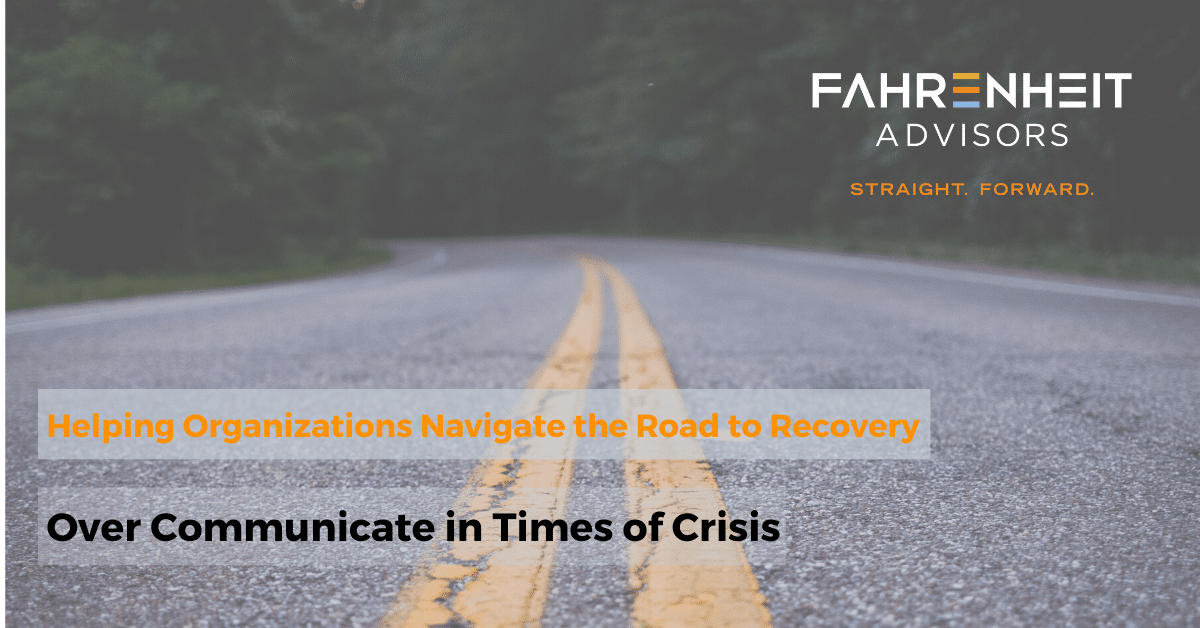Over Communicate in Times of Crisis: COVID-19

Many years ago, I had a unique opportunity to attend a week long seminar on Change Management conducted by the change guru Daryl Connor. One of the key takeaways from the course was that most leaders give themselves far too much credit for how effective their communication is to the people and organizations they lead and manage. He went on to say we give ourselves far too many pats on the back with respect to both the frequency and clarity of our communication. The bottom line is most of us as leaders under communicate!
The reality of this was brought to me front and center on September 11, 2001. I was at the Denver airport getting ready to board a flight to Kingston, Ontario to visit our brand-new call center with 700 new team members. At the time, I was a CEO of a middle market, public, business process outsourcing company located in Colorado. As many of us will recall it was a day of terror filled with fear, rumors and lots of speculation by the media as to what was really going on in the first few hours after the attacks. In many ways it was a day dominated by chaos.
What became very clear on 9/11 and the first few days following the attack was that we needed to over communicate with our three key constituencies – clients, employees and shareholders. What we were communicating needed to be both timely and factual. In addition, we created a Communication Task Force with me as the Chairperson. We decided the following:
- As CEO, I would own daily communication with the senior leaders at our largest clients,
- The COO would own communication with the balance of our clients, and
- The Head of Human Resources would own employee communication
We also agreed that the leadership team should focus on the business and the Chairman of the Board would own communication with the Board and Wall Street.
During the first couple of weeks following 9/11 we held daily “touch base” calls with all three constituencies. We made it very clear that these were two-way communication calls as it was just as important for us to hear what was happening with our clients and employees at our 18 field operating sites as it was to inform them what was happening at HQ.
There are many parallels between COVID-19 and 9/11. In fact, I would say COVID-19 offers even more of a dramatic challenge from a communication standpoint than 9/11 did. This pandemic event is going on much longer and is directly touching every state in the country, where with 9/11, the focal point of the primary attacks were New York and Washington D.C.. Today you also have to add in the impact the role social media plays with respect to how people send and receive information which did not exist in 2001.
I would say that COVID-19 requires over communication squared as compared to 9/11. Today information is coming from the President, a Task Force, medical experts, governors and state officials these messages are not always fully aligned.
So do yourself, your clients and your organization a big favor and whatever you have been doing regarding communication for the past few weeks- increase the frequency and solicit for what your organization does not feel they are getting from a communication standpoint.
Clearly your organization has made many changes during the COVID-19 crisis. When we begin to return to normal do not go back to the way you use to do everything. Step back and take the time to analyze the changes you have made. Keep what you feel has been positive change as it relates to communication and keeping your clients and team members informed. This will be a great opportunity to determine what should stay and what should go with all aspects of your business.
In closing, remember your starting point was one of under communication. In times of chaos and crisis all leaders at all levels must over communicate.
 About the Author
About the Author
Bill Meade has an extensive business career at senior levels with a strong background in business process outsourcing, not for profits, and financial services. He left the corporate world in 2005 and formed a partnership which focused on investments in the retail food segment and business process outsourcing. During the past two years, Bill has devoted a considerable amount of time assisting three not-for-profit organizations with long term strategy and fundraising. During Bill’s years in the corporate world he was known for being an exceptional coach to his senior leaders and staff. As a leader that understands the benefit of professional development, Bill’s coaching participants found great benefit in his wisdom and focus to leverage their strengths and grow within their organizations. Bill’s firm belief is that growth in an organization comes from ongoing and continued development
